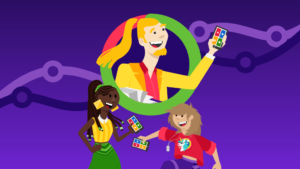
Through his 10+ years in education, Matt’s garnered skill and expertise that ensure powerful play and curious learning for his students, whether they’re high school players or veteran colleagues. Today, Matt shares his tips and tricks for the transitioning teacher; between virtual learning, in-person instruction, and back again. Read on for strategies to embed consistency, continuity, and collaboration in your classroom!
Matt, tell us a little about your current role.
I teach high school (Year 7-12) Digital Technologies and Design. I am also a school leader in the areas of Digital Learning, Technologies Curriculum, Vocation Education and Training and post school pathways.
We know that [globally] teachers are working hard to maintain structure for their classrooms and students in the pivots between in-person and online instruction. What has been your biggest challenge through these changing dynamics?
I have always found teaching is very rewarding, but it is certainly not without its challenges! The biggest thing for me has always been time. Especially given my increasing leadership responsibilities, it is important that technology in the classroom provides time savings and Kahoot! is quick and easy to use. It only takes a few minutes to find a Kahoot! [on the Discover page] to use with students, and only a few more minutes to customize it to my specific needs.
Awesome! That sounds perfect for on-the-fly planning, it sounds as schedules are disrupted in different learning environments and changes…awesome! How long have you been using Kahoot! to spark curiosity?
I have been using Kahoot! since 2016, so about 5 years. It was originally suggested to me by a teaching colleague and I found it to be revolutionary (and I still think that now!). While in the classroom, I use a kahoot at the beginning or end of a class, for excellent scope as a ‘fire up’ game, or as an opportunity to check for understanding. I’m passionate about cognitive capacity and brain elasticity and I have used Kahoot! a lot with students to develop these skills through the use of brain games and puzzles. Lately, I’ve been using Kahoot! more specifically with colleagues, as it’s so simple to share a great Kahoot! across the school, making virtual planning meetings even easier!
Sharing kahoots looks like awesome collaboration! As teachers integrate technology into their online, virtual, or hybrid learning experiences, what recommendations can you share for building your Kahoot! toolbox?
Assign your students a nickname. Country names, colors, or numerical codes have worked well for me! For each game, students will enter their prescribed nickname to start the game. Student scores and progress will be anonymous to everyone but themselves and the teacher, and these nicknames are easier to track in reports, too!
Thanks, Matt! And since you mentioned Reports, we can also remind educators that Kahoot!’ing isn’t over when you get to the Podium. In fact, lots can be learned from the Reports! How have you used this feature for your classes?
Reports have grown so much over the years and are really awesome. There are so many amazing things you can do here, but a favorite of mine is the ability to rename Kahoots! after you’ve played them (to add a date, class code etc.). This is a game changer if you want to be able to track understanding over time or across different class periods, sections, or rosters.
Awesome! When educators use Reports for the first time, what top tips do you have for making the most of the feature?
- Start today! The biggest hurdle is using Reports the first time. After you allot time for learning and integration, you’ll be back to try again in no time!
- Use player and question insights! I will generally look at the insights on the ‘players’ and ‘questions’ pages of the report to assess mastery or opportunities for remediation. The ‘need help’ and ‘didn’t finish’ filters are really great as a quick snapshot of who needs extra support and the ‘questions’ tab provides a lot of great insights for student feedback.
- Rename reports to ensure they are meaningful for long-term assessment, responsive planning, and progress monitoring.
Amazing! We know you’re a long time lover of Kahoot!, Matt. Thanks so much for sharing your expertise and experience with us! What can educators do today to make for powerful play right away?
Utilize the Feedback feature after a kahoot has finished! So much information can be collected from this quick exit survey. The Feedback filter tells me what my students think of the instruction and content. I know how to tailor follow-up lessons and conversations to better meet their needs. It’s awesome!

Thanks, Matt (and all of his students & players) for sharing so many top tips and tricks to make learning awesome with Kahoot!…wherever you are!
Inspired by Matt’s story? Try this type of progress-monitoring and responsive instruction with your students! Reports are available for all K-12 teachers for free. In Kahoot! EDU, you can gain access to individualized content and assessment tools (like class Courses and Player Identifier).




